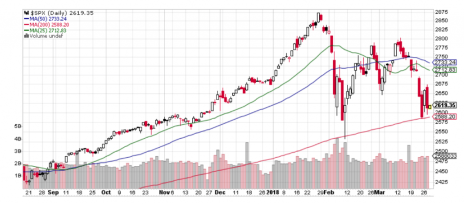If you’re a growth investor, it isn’t a surprise to you that stock markets have been in a foul mood for about two months now. The market correction started on January 29 with an insignificant down day that didn’t even erase the previous day’s gains. But the S&P 500 gapped down on January 30, then got seriously bearish in a hurry. As you can see from the chart, the S&P, which had reached 2,873 on January 28, got slammed to an intraday low of 2,533 on February 9 before starting a rebound rally.
But that rally, and the one that started on March 2, both failed, and the latest down leg included the wipeout days of March 22 and 23.
Right now, the S&P is effectively retesting its February lows, but has (so far) found support at its 200-day moving average.
It’s not like the buyers haven’t put up a fight. The trading volume spikes on the up days of February 6 and 9 and March 16 show that there’s still some buying appetite out there. But the 25-day moving average has dipped below its 50-day and both are heading down.
Most commentators are burning up their keyboards assigning blame for this market correction, with actions in Washington, D.C. getting the bulk of the opprobrium. And the ones who aren’t playing the blame game are trying to read the tea leaves to predict when it will end.




Trying to answer the “why” and “how long” questions is fine, in a theoretical, analytical kind of way. But it leaves out the most important question for growth investors, which is, “What should I be doing right now?”
And the answer is that you should be reducing your exposure to growth stocks by taking partial profits in your winners, selling your losers and cutting way back on new buying. When the market is biting you, the way to bite back is by shifting your money off the playing field and benching it on the sidelines until conditions improve.
Taking money off the table is a hard thing for growth investors to do because they’re generally optimists by nature and want to hold on until the market comes to its senses and starts rising again.
But if you’re in that position—knowing that the market has turned against you but wanting to just gut it out until the buyers retake leadership—here is a statistical truth to help you talk yourself into doing some selling.
Remember that if a stock suffers a loss of 10%, it must rebound by 11.1% to get back to even. And the bigger the loss, the bigger the gain required to make up for it. A stock that falls by 25% must appreciate 33% to regain its starting price. And a 50% loss needs a 100% gain to return to its original value.
You don’t have to hit the PANIC button and sell everything. In fact, doing that is almost always counterproductive. But a little selling can help you sleep a little better at night as you wait out this market correction. When the market is riding the down escalator, the best revenge is step off.





